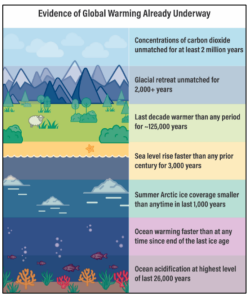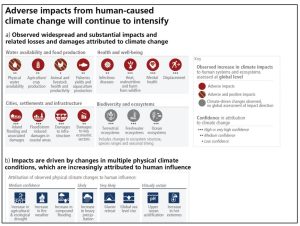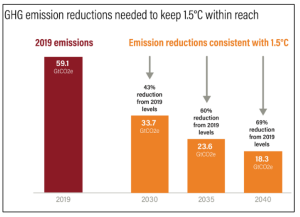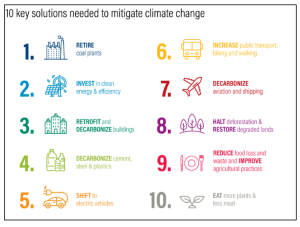Top Takeaways from the IPCC’s AR6 Synthesis Report: Climate Change 2023
Posted: March 29th, 2023
Authors: James G.
On March 20, 2023, the United Nations Intergovernmental Panel on Climate Change (IPCC), the world’s leading authoritative body on climate science, released its final installment of its Sixth Assessment Report (AR6) which is the AR6 Synthesis Report: Climate Change 2023. The IPCC started releasing their assessment reports on climate change beginning in 1990 and are the main resource for policymakers for understanding the current state of global climate change. The latest AR6 report has taken the IPCC eight years to complete and is the final report in its current reporting cycle with the next round of reporting expected in the 2030’s. The AR6 Synthesis Report was developed based on the content in the three Working Group Assessment Reports: Working Group I – The Physical Science Basis, Working Group II – Impacts, Adaptation and Vulnerability, Working Group III – Mitigation of Climate Change, and the three Special Reports: Global Warming of 1.5°C, Climate Change and Land, and The Ocean and Cryosphere in a Changing Climate. These reports were published by the IPCC between 2018 and 2022.
The changes we are experiencing on planet Earth due to global warming have been well documented by the IPCC in their assessment reports with the most recent AR6 reports painting a grim picture of the future if we continue on our current path. The AR6 Synthesis Report is being described as a final warning to society that the window to mitigate GHG emissions needed to advert catastrophic climate change is closing, and that efforts to adapt to climate change will only become more challenging in a warmer future. The AR6 Synthesis Report provides an overview of the status of global climate change with an outlook for the future with recommendations. Below is a summary of the top takeaways of the report broken down by each section.
Section A: Current Status and Trends
Human-induced global warming, which has already reached 1.1 degrees Celsius, has spurred changes to the Earth’s climate that are unprecedented in recent human history. Human activities, primarily through greenhouse gas (GHG) emissions, have unequivocally caused global warming, with global surface temperatures reaching 1.1 degrees Celsius above preindustrial (1850-1900) levels. GHG emissions have continued to rise due to the continued use of fossil fuels, unsustainable land use practices, and other unsustainable patterns of consumption and production. These disparities exist across all regions, between and within countries, and among individuals. The graphic below highlights the IPCC’s key findings of evidence that global warming is already underway.

https://www.wri.org/insights/ipcc-climate-report
The widespread and rapid changes in our environment have led to a range of unfavorable impacts on the planet, with vulnerable communities disproportionately being affected. While adaptation planning and implementation have progressed, adaptation gaps persist and will grow if current human-induced GHG emissions rates continue without mitigation. Some ecosystems and regions have already reached their limits for adaptation, and maladaptation, the failure to adapt or adjust adequately or appropriately, occurs in specific sectors and regions. Furthermore, the financial support for adaptation remains insufficient, especially in developing countries.
The current Nationally Determined Contributions (NDCs) suggest that global warming will likely exceed 1.5 degrees Celsius during this century, making it more difficult to keep global warming below 2 degrees Celsius in the future. The projected GHG emissions from existing policies and financial institutions are currently not enough to meet the climate goals across all sectors and regions, highlighting the need for urgent accelerated action. The following graphic taken from the AR6 Synthesis Report describes how the adverse impacts from human-caused climate change will continue to intensify and evolve if no action is taken by society to curb GHG emissions.
https://report.ipcc.ch/ar6syr/pdf/IPCC_AR6_SYR_SPM.pdf
Section B: Future Climate Change, Risks, and Long-Term Responses
Climate-related risks are now higher than assessed in previous IPCC reports, with long-term impacts up to multiple times higher than currently observed. These risks escalate with each increment of global warming and will increasingly interact with non-climatic risks, creating compound and cascading effects that are more complex and more challenging to manage. Each additional increment of global warming that we experience will result in the intensification of multiple concurrent hazards. Avoiding these impacts will require deep, rapid, and sustained reductions in GHG emissions now. These reductions could begin to slow global warming within two decades and lead to noticeable changes in atmospheric composition within a few years. The United Nations Secretary-General Antonio Guterres remarked on the AR6 report findings stating that “the climate time bomb is ticking. But today’s IPCC report is a how-to guide to defuse the climate time bomb. It is a survival guide for humanity… as it shows, the 1.5°C limit is achievable. But it will take a quantum leap in climate action.”1
According to the Synthesis Report, some future changes in our climate are unavoidable or irreversible but can still be limited by significant GHG emissions reductions. With higher global warming levels, the likelihood of abrupt or irreversible changes increases, as does the probability of low-likelihood outcomes associated with potentially severe adverse impacts. The Synthesis report demonstrates that some climate impacts are already so severe they cannot be adapted to, leading to greater losses and damage. As global warming continues to increase, adaptation options will become constrained and less effective. Losses and damage will rise, and additional human and natural systems will reach adaptation limits. Maladaptation can still be avoided through the implementation of comprehensive adaptation actions. This will require multi-sectoral and inclusive, long-term planning and implementation. However, this will also bring co-benefits across various sectors and systems.
Limiting human-caused global warming will ultimately require net-zero carbon dioxide (CO2) emissions. Cumulative carbon emissions, and actions to start making significant carbon reductions, during this decade will largely determine whether warming can be limited to 1.5 degrees Celsius or even 2 degrees Celsius. “The IPCC finds that there is a more than 50% chance that global temperature rise will reach or surpass 1.5 degrees Celsius [before] 2040 across studied scenarios, and under a high-emissions pathway, specifically, the world may hit this threshold even sooner, [before] 2037. Global temperature rise in such a carbon-intensive scenario could also increase to 3.3 degrees Celsius to 5.7 degrees Celsius by 2100. To put this projected amount of warming into perspective, the last time global temperatures exceeded 2.5 degrees Celsius above pre-industrial levels was more than 3 million years ago.”2 The following graphic shows the GHG emissions reductions needed to keep the 1.5 degrees Celsius goal within reach.
https://www.wri.org/insights/2023-ipcc-ar6-synthesis-report-climate-change-findings
Without abatement, the existing fossil fuel infrastructure would result in projected CO2 emissions exceeding the remaining carbon budget for the 1.5 degrees Celsius pathway. Therefore, the world must rapidly shift away from burning fossil fuels which the IPCC considers the number one cause of the climate crisis. Modelled pathways to limit warming to 1.5 degrees Celsius or 2 degrees Celsius involve rapid, deep, and in most cases, immediate GHG emissions reductions in all sectors this decade. Global emissions are required to reach net-zero CO2 in the early 2050’s for 1.5 degrees Calcius pathways and the early 2070’s for 2 degrees Celsius pathways. If warming exceeds a specified level like 1.5 degrees Celsius, it could be gradually reduced by achieving and sustaining net-negative global CO2 emissions. This would require additional carbon dioxide removal, leading to greater feasibility and sustainability concerns. The AR6 Synthesis Report highlights that technology like carbon removal and the development of alternative low carbon fuels for transportation are now essential to limit the global temperature rise to 1.5 degrees Celsius.
The AR6 Synthesis Report now acknowledges the probability of a climate overshoot. Climate overshoot is the period in which warming increases past the 1.5 degrees Celsius threshold and then cools back down to a steady-state level below the 1.5 degrees Celsius threshold. “About 90 percent of climate models predict a period of climate overshoot, with years if not decades of higher global temperatures, before stabilizing at 1.5°C.”3 Climate overshoot would mean long periods of higher global temperatures that could result in catastrophic climate change. The additional climate-related risks for human and natural systems increase and are less predictable depending on the magnitude and duration of the overshoot.
Section C: Urgency of Near-Term Integrated Climate Action
The AR6 Synthesis Report states that climate change poses a dire threat to human well-being and planetary health, with a fast-shrinking window of opportunity to secure a livable and sustainable future for all. Swift and comprehensive climate action, this decade, could greatly reduce the projected losses and damages for humans and ecosystems in the future, while also providing numerous co-benefits such as improved air quality and health. However, delayed action could result in significant costs and irreversible consequences now, and for thousands of years into the future.
Achieving a sustainable future requires rapid, far-reaching transitions across all sectors, with the utilization of a diverse array of mitigation and adaptation strategies. Effective climate action is enabled through political commitment, well-aligned governance, institutional frameworks, and enhanced access to finance and technology. Clear goals, coordination, and inclusive governance processes facilitate impactful climate action, with regulatory and economic instruments playing a pivotal role. Equity, climate justice, and social inclusion are critical in driving ambitious climate actions and climate-resilient development, as support for the most vulnerable regions and populations is paramount. Climate change, as well as our collective efforts to adapt to and mitigate it, will exacerbate inequity should we fail to ensure a just transition.
Climate resilient development benefits from incorporating diverse knowledge sources. Financing, technology, and international cooperation are essential for accelerated climate action. To achieve climate goals, both adaptation and mitigation financing must increase exponentially. While there is sufficient global capital to close investment gaps, barriers to redirecting capital to climate action must be addressed. Enhancing technology innovation systems and international cooperation through various channels will be key to driving global climate action forward. The graphic below from the World Resources Institute summarizes ten key solutions highlighted in the AR6 reports that will be needed to mitigate climate change and keep the planet on the 1.5 degrees Celsius pathway.
https://www.wri.org/insights/2023-ipcc-ar6-synthesis-report-climate-change-findings
If you are interested in learning more about how ALL4 can assist your company with emissions reduction strategies, net-zero goals, or adaptation, please reach out to ALL4’s James Giannantonio, Managing Consultant of ESG & Sustainability, at jgiannantonio@all4inc.com.
Sources:
- https://report.ipcc.ch/ar6syr/pdf/IPCC_AR6_SYR_SPM.pdf
- https://www.ipcc.ch/report/ar6/syr/
- https://www.wri.org/insights/ipcc-climate-report
- https://www.wri.org/insights/2023-ipcc-ar6-synthesis-report-climate-change-findings
- https://www.weforum.org/agenda/2023/03/climate-change-ipcc-emissions-risks-net-zero/
- https://www.ipcc.ch/about/history/#:~:text=In%201990%2C%20the%20First%20IPCC,consequences%20and%20requiring%20international%20cooperation
- https://www.edie.net/we-need-to-change-course-urgently-green-economy-responds-to-ipcc-report/
- https://www.worldwildlife.org/stories/what-is-climate-overshoot-and-why-does-it-matter#:~:text=What%20does%20a%20climate%20overshoot,is%20called%20a%20climate%20overshoot
- [1]‘We need to change course urgently’: Green economy responds to IPCC report
- [2]10 Big Findings from the 2023 IPCC Report on Climate Change
- [3]What is climate overshoot and why does it matter?




